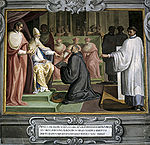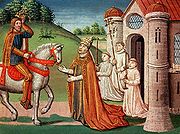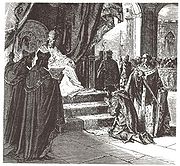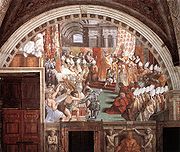
Frankish Papacy
Encyclopedia

Byzantine Empire
The Byzantine Empire was the Eastern Roman Empire during the periods of Late Antiquity and the Middle Ages, centred on the capital of Constantinople. Known simply as the Roman Empire or Romania to its inhabitants and neighbours, the Empire was the direct continuation of the Ancient Roman State...
to the that of the kings of the Franks. Pepin the Short (ruled 751–768), Charlemagne
Charlemagne
Charlemagne was King of the Franks from 768 and Emperor of the Romans from 800 to his death in 814. He expanded the Frankish kingdom into an empire that incorporated much of Western and Central Europe. During his reign, he conquered Italy and was crowned by Pope Leo III on 25 December 800...
(r. 768–814) (co-ruler with his brother Carloman I until 771), and Louis the Pious
Louis the Pious
Louis the Pious , also called the Fair, and the Debonaire, was the King of Aquitaine from 781. He was also King of the Franks and co-Emperor with his father, Charlemagne, from 813...
(r. 814-840) had considerable influence in the selection and administration of popes. The "Donation of Pepin
Donation of Pepin
The "Donation of Pepin", the first in 754, and second in 756, provided a legal basis for the formal organizing of the Papal States, which inaugurated papal temporal rule over civil authorities...
" (756) ratified a new period of papal rule in central Italy, which became known as the Papal States
Papal States
The Papal State, State of the Church, or Pontifical States were among the major historical states of Italy from roughly the 6th century until the Italian peninsula was unified in 1861 by the Kingdom of Piedmont-Sardinia .The Papal States comprised territories under...
.
This shift was initiated by the Lombards
Lombards
The Lombards , also referred to as Longobards, were a Germanic tribe of Scandinavian origin, who from 568 to 774 ruled a Kingdom in Italy...
conquering the Exarchate of Ravenna
Exarchate of Ravenna
The Exarchate of Ravenna or of Italy was a centre of Byzantine power in Italy, from the end of the 6th century to 751, when the last exarch was put to death by the Lombards.-Introduction:...
from the Byzantines, strengthened by the Frankish triumph over the Lombards, and ended by the fragmentation of the Frankish Kingdom into West Francia, Middle Francia
Middle Francia
Middle Francia was an ephemeral Frankish kingdom created by the Treaty of Verdun in 843, which divided the Carolingian Empire among the sons of Louis the Pious...
, and East Francia. Lothair I
Lothair I
Lothair I or Lothar I was the Emperor of the Romans , co-ruling with his father until 840, and the King of Bavaria , Italy and Middle Francia...
continued to rule Middle Francia, which included much of the Italian peninsula from 843 to 855.
Pepin the Short
Following the death of ZacharyPope Zachary
Pope Saint Zachary was Pope of the Catholic Church from 741 to 752. A Greek from Calabria, he was the last pope of the Byzantine Papacy...
, the last culturally Greek pope, Stephen II
Pope Stephen II
Pope Stephen II was Pope from 752 to 757, succeeding Pope Zachary following the death of Pope-elect Stephen. Stephen II marks the historical delineation between the Byzantine Papacy and the Frankish Papacy.-Allegiance to Constantinople:...
(752-757) became the first pope to cross the Alps
Alps
The Alps is one of the great mountain range systems of Europe, stretching from Austria and Slovenia in the east through Italy, Switzerland, Liechtenstein and Germany to France in the west....
, in 752, when he appealed in person for the aid of Pepin the Short upon his election, following the Lombard
Lombards
The Lombards , also referred to as Longobards, were a Germanic tribe of Scandinavian origin, who from 568 to 774 ruled a Kingdom in Italy...
takeover of Ravenna in 751. The Lombards had extinguished the exarchate of Ravenna
Exarchate of Ravenna
The Exarchate of Ravenna or of Italy was a centre of Byzantine power in Italy, from the end of the 6th century to 751, when the last exarch was put to death by the Lombards.-Introduction:...
and turned their attention to the formerly Byzantine Duchy of Rome
Duchy of Rome
The Duchy of Rome was a Byzantine district in the Exarchate of Ravenna. Like other Byzantine states in Italy, it was ruled by an imperial functionary with the title dux...
. Stephen II, of course, asked Constantinople for help, but the Eastern Romans had their own problems, so he traveled all the way to the palatium at Quierzy, where the reluctant Frankish nobles finally gave their consent to a campaign in Lombardy. For his part, then and there, Pepin executed in writing a promise to convey to the Papacy certain territories that were going to be wrested from the Lombards. No actual document has been preserved, but later 8th century sources quote from it. Fulfilling his part, in Paris Stephen anointed him as King of the Franks in a lavish ceremony at the Basilica of St Denis, bestowing upon him the additional title of patricius Romanorum (Patrician of the Romans). The "Donation of Pepin
Donation of Pepin
The "Donation of Pepin", the first in 754, and second in 756, provided a legal basis for the formal organizing of the Papal States, which inaugurated papal temporal rule over civil authorities...
" strengthened the claim of the popes to the de facto core of the Papal States
Papal States
The Papal State, State of the Church, or Pontifical States were among the major historical states of Italy from roughly the 6th century until the Italian peninsula was unified in 1861 by the Kingdom of Piedmont-Sardinia .The Papal States comprised territories under...
, and thus the incentives for secular interference in papal selection.
Stephen II's brother and successor was Pope Paul I
Pope Paul I
Pope Paul I was pope from May 29, 757 to June 28, 767. He first served as a Roman deacon and was frequently employed by his brother, Pope Stephen II, in negotiations with the Lombard kings....
(757-767). According to the Catholic Encyclopedia:
- "While Paul was with his dying brother at the Lateran, a party of the Romans gathered in the house of Archdeacon TheophylactCounts of TusculumThe counts of Tusculum were the most powerful secular noblemen in Latium, near Rome, in the present-day Italy between the 10th and 12th centuries. Several popes and an antipope during the 11th century came from their ranks. They created and perfected the political formula of noble-papacy, wherein...
in order to secure the latter's succession to the papal see. However, immediately after the burial of Stephen (died 26 April, 757), Paul was elected by a large majority, and received episcopal consecration on the twenty-ninth of May. Paul continued his predecessor's policy towards the Frankish king, Pepin, and thereby continued the papal supremacy over Rome and the districts of central Italy in opposition to the efforts of the Lombards and the Eastern Empire."
The death of Paul I was followed by a bloody schism characterized by Toto of Nepi
Toto of Nepi
Toto was the self-styled duke of Nepi, the leading magnate of Etruria, who staged a coup d'état in Rome in 767. He became Duke of Rome for a year until his death...
and Pope Stephen III
Pope Stephen III
Pope Stephen III was pope from August 1 or August 7, 768 to January 24, 772. He was a native of Sicily.He came to Rome during the pontificate of Gregory III and gradually rose to high office in the service of successive popes....
(768-772). Toto Supported the claim of his layman brother, Antipope Constantine; a small group of Lombards also supported the rival claim of a monk named Philip. According to the Catholic Encyclopedia, "through the support of the brothers Charlemagne and Carloman, Kings of the Franks, Stephen was able to recover some territories from the Lombards." However, the Lombard King Desiderius
Desiderius
Desiderius was the last king of the Lombard Kingdom of northern Italy...
married his daughter to Charlemagne, and "in some mysterious manner effected the fall of the pope's chief ministers, Christopher and Sergius."
After Toto had his eyes gouged out and was imprisoned, Stephen III decreed that the entire Roman clergy had the right to elect the pope but restricted eligibility for election to the cardinal-priests and cardinal-deacons (incidentally, the first use of the term "cardinals" to refer to the priests of the titular churches or the seven deacons); the cardinal-bishops, supporters of Toto, were excluded. Of course, the Roman laity quickly regained its role after Stephen III's decree, and maintained its participation until 1059.

Charlemagne
Pope Adrian IPope Adrian I
Pope Adrian was pope from February 1, 772 to December 25, 795. He was the son of Theodore, a Roman nobleman.Shortly after Adrian's accession the territory ruled by the papacy was invaded by Desiderius, king of the Lombards, and Adrian was compelled to seek the assistance of the Frankish king...
(772-795) and Pope Leo III
Pope Leo III
Pope Saint Leo III was Pope from 795 to his death in 816. Protected by Charlemagne from his enemies in Rome, he subsequently strengthened Charlemagne's position by crowning him as Roman Emperor....
(795-816) were elected under the rules of Stephen III, but the latter was forced from Rome and sought the aid of Charlemagne
Charlemagne
Charlemagne was King of the Franks from 768 and Emperor of the Romans from 800 to his death in 814. He expanded the Frankish kingdom into an empire that incorporated much of Western and Central Europe. During his reign, he conquered Italy and was crowned by Pope Leo III on 25 December 800...
. Under the rule of Adrian I, Charlemagne conquered Pavia
Pavia
Pavia , the ancient Ticinum, is a town and comune of south-western Lombardy, northern Italy, 35 km south of Milan on the lower Ticino river near its confluence with the Po. It is the capital of the province of Pavia. It has a population of c. 71,000...
, ending the Lombard kingdom "and the Papacy was forever delivered from its persistent and hereditary foe." Adrian I played a pivotal role in the fall of Pavia
Siege of Pavia
The Siege or Battle of Pavia was fought in 773–774 in what is now northern Italy, near Ticinum , and resulted the victory of Franks under Charlemagne against the Lombards under king Desiderius.-Background:...
, and scholars have long assumed that he consistently supported the Frankish efforts to destroy Lombard power; however, the actual situation might be more complicated. Charlemagne confirmed the election of Leo II, sending Angilbert, Abbot of St. Regnier
Angilbert
Saint Angilbert was a Frank who served Charlemagne as a diplomat, abbot, poet and semi-son-in-law. He was of noble Frankish parentage, and educated at the palace school in Aquae Grani under Alcuin...
, to Rome to carry to the new Pope admonitions about the proper filling of his office. Leo III was consecrated the day after his election, an unusual move perhaps intended to preempt any Frankish interference.
Louis the Pious
Pope Stephen IVPope Stephen IV
Pope Stephen IV was Pope from June 816 to January 817.He succeeded Leo III, whose policies favoring clergy over lay aristocracy he did not continue. Immediately after his consecration he ordered the Roman people to swear fidelity to the Frankish king Louis the Pious, to whom he went personally in...
(816-817) required the Romans to take an oath to Charlemagne's son, Louis the Pious
Louis the Pious
Louis the Pious , also called the Fair, and the Debonaire, was the King of Aquitaine from 781. He was also King of the Franks and co-Emperor with his father, Charlemagne, from 813...
, as their suzerain
Suzerainty
Suzerainty occurs where a region or people is a tributary to a more powerful entity which controls its foreign affairs while allowing the tributary vassal state some limited domestic autonomy. The dominant entity in the suzerainty relationship, or the more powerful entity itself, is called a...
, and he sent notice of his election to him before traveling to France to crown Louis. Pope Paschal I
Pope Paschal I
Pope Saint Paschal I was pope from January 25, 817 to February 11, 824. A native of Rome and son of Bonosus, he was raised to the pontificate by the acclamation of the clergy, shortly after the death of Pope Stephen IV, and before the sanction of the emperor Louis the Pious had been obtained - a...
(817-824) sent "several ambassadors in rapid succession" to Louis before receiving from him the Pactum Ludovicianum, confirming the Donation of Pepin.

Pope Eugene II
Pope Eugene II, , pope was a native of Rome and was chosen to succeed Paschal I. Another candidate, Zinzinnus, was proposed by the plebeian faction, and the presence of Lothair I, son of the Frankish emperor Louis the Pious was necessary in order to maintain the authority of the new pope...
(824-827). According to the Catholic Encyclopedia, "the election of Eugene II was a triumph for the Franks" and Louis "accordingly sent his son Lothair
Lothair
Lothair is a Germanic given name, derived from the older form Clotaire .- People :It can refer to these people:*Lothair I , a King of Italy and Holy Roman Emperor...
to Rome to strengthen the Frankish influence." The pope and emperor signed a concordat or constitution in 824. The papal subjects were made to swear fealty to Louis and Lothair and were not to "suffer the pope-elect to be consecrated save in the presence of the emperor's envoys." This was approximately the status quo circa 769, reincorporating the lay Roman nobles (who continued to dominate the process for 200 years) and requiring the pope to swear loyalty to the Frankish ruler.
The consecration of Pope Gregory IV
Pope Gregory IV
Pope Gregory IV was chosen to succeed Valentine in December 827, on which occasion he recognized the supremacy of the Frankish emperor Louis the Pious in the most unequivocal manner....
(827-844) was delayed for six months to attain the assent of Louis. Gregory IV was the candidate of the "secular nobility of Rome who were then securing a preponderating influence in papal elections" and thus "the representatives in Rome of the Emperor Louis the Pious" required this delay. Because of this delay, Gregory IV could not begin to govern the church until March 828.
The clergy and the nobles elected different candidates in 844. Because Pope Sergius II
Pope Sergius II
Pope Sergius II was Pope from January 844 – January 24, 847.On the death of Gregory IV the archdeacon John was proclaimed pope by popular acclamation, while the nobility elected Sergius, a Roman of noble birth. The opposition was suppressed, with Sergius intervening to save John's life...
(844-847) was, "after a disputed election, consecrated without any reference to the Emperor Lothaire
Lothair I
Lothair I or Lothar I was the Emperor of the Romans , co-ruling with his father until 840, and the King of Bavaria , Italy and Middle Francia...
, the latter was indignant, and sent his son Louis with an army to examine into the validity of the election." Only when "Sergius succeeded in pacifying Louis, whom he crowned king" did Lothair I
Lothair I
Lothair I or Lothar I was the Emperor of the Romans , co-ruling with his father until 840, and the King of Bavaria , Italy and Middle Francia...
side with Sergius II, the noble candidate.
Aftermath
Three years later Pope Leo IVPope Leo IV
Pope Saint Leo IV was pope from 10 April 847 to 17 July 855.A Roman by birth, he was unanimously chosen to succeed Sergius II. When he was elected, on 10 April 847, he was cardinal of Santi Quattro Coronati, and had been subdeacon of Gregory IV and archpriest under his predecessor...
(847-855) was again consecrated without imperial approval, which would have been difficult in any case as the Carolingian Empire was in the process of breaking up. Lothair II of Lotharingia
Lothair II of Lotharingia
Lothair II was the second son of Emperor Lothair I and Ermengarde of Tours. He was married to Teutberga, daughter of Boso the Elder. He is the namesake of the Lothair Crystal, which he probably commissioned, and of the Cross of Lothair, which was made over a century after his death but...
indeed failed to impose his own candidate, Pope Benedict III
Pope Benedict III
Pope Benedict III was Pope from September 29, 855 to April 17, 858.Little is known of Benedict's life before his papacy. He was educated and lived in Rome and was cardinal priest of S. Callisto at the time of his election. Benedict had a reputation for learning and piety. He was elected upon the...
(855-858), in 855 until the Roman-elected candidate refused the office (the first recorded historical refusal). According to the Catholic Encyclopedia:
- "On the death of Leo IV (17 July, 855) Benedict was chosen to succeed him, and envoys were despatched to secure the ratification of the decree of election by the Emperors Lothaire and Louis II. But the legates betrayed their trust and allowed themselves to be influenced in favour of the ambitious and excommunicated Cardinal AnastasiusAnastasius BibliothecariusAnastasius Bibliothecarius was Head of archives and antipope of the Roman Catholic Church.- Family and education :...
. The imperial missi, gained over in turn by them, endeavoured to force Anastasius on the Roman Church."
Lothair II was present for the election of Pope Nicholas I
Pope Nicholas I
Pope Nicholas I, , or Saint Nicholas the Great, reigned from April 24, 858 until his death. He is remembered as a consolidator of papal authority and power, exerting decisive influence upon the historical development of the papacy and its position among the Christian nations of Western Europe.He...
(858-867), who prohibited anyone outside of the Roman community from interfering in papal elections, and as a result Pope Adrian II
Pope Adrian II
Pope Adrian II , , pope from December 14, 867 to December 14, 872, was a member of a noble Roman family, and became pope in 867, at an advanced age....
(867-872) was consecrated without even informing the Franks. Lothair II's choice of Nicholas I was contrary to the wishes of the clergy, but "was confirmed without much ado" and Nicholas I was crowned in the emperor's presence.

Pope Marinus I
Pope Marinus I , Pope between December 16, 882 and May 15, 884. He succeeded John VIII in about the end of December 882.-Prior history:...
(882-884) was consecrated "without waiting for the consent of the incompetent emperor, Charles the Fat
Charles the Fat
Charles the Fat was the King of Alemannia from 876, King of Italy from 879, western Emperor from 881, King of East Francia from 882, and King of West Francia from 884. In 887, he was deposed in East Francia, Lotharingia, and possibly Italy, where the records are not clear...
." Pope Stephen V
Pope Stephen V
Pope Stephen V was pope from 885 to 891. He succeeded Pope Adrian III, and was in turn succeeded by Pope Formosus. In his dealings with Constantinople in the matter of Photius, as also in his relations with the young Slavonic church, he pursued the policy of Pope Nicholas I.His father, Hadrian, who...
(885-891) was similarly consecrated, and Charles the Fat may have intervened had Stephen V not been elected unanimously.
The coins of Pope Romanus
Pope Romanus
Pope Romanus was Pope from August to November 897.He was born in Gallese, Italy near Civita Castellana.He was elected to succeed the murdered Pope Stephen VI and was deposed a few months later by one of the factions, which then governed Rome. His short rule was regarded as a virtuous one by the...
(879) continued to bear the name of Emperor Lambert as well as his own monogram. A synod in Rome decided that Pope John IX
Pope John IX
-Early life:Little is known about John IX before he became Pope. Born in Tivoli in an unknown year, he was ordained as a Benedictine priest by Pope Formosus...
(898-900) should not be consecrated except in the presence of "imperial envoys."
Legacy

Otto I, Holy Roman Emperor
Otto I the Great , son of Henry I the Fowler and Matilda of Ringelheim, was Duke of Saxony, King of Germany, King of Italy, and "the first of the Germans to be called the emperor of Italy" according to Arnulf of Milan...
created Magdeburg
Archbishopric of Magdeburg
The Archbishopric of Magdeburg was a Roman Catholic archdiocese and Prince-Bishopric of the Holy Roman Empire centered on the city of Magdeburg on the Elbe River....
in 963, and Henry II, Holy Roman Emperor
Henry II, Holy Roman Emperor
Henry II , also referred to as Saint Henry, Obl.S.B., was the fifth and last Holy Roman Emperor of the Ottonian dynasty, from his coronation in Rome in 1014 until his death a decade later. He was crowned King of the Germans in 1002 and King of Italy in 1004...
created Bamberg
Prince-Bishopric of Bamberg
The Bishopric of Bamberg was established in 1007, to further expand the spread of Christianity in Germany. The ecclesiastical state was a member of the Holy Roman Empire from about 1245 until it was subsumed to the Electorate of Bavaria in 1802...
in 1020—and to strongly influence decisions nominally made by the pope. Pope Gregory IV
Pope Gregory IV
Pope Gregory IV was chosen to succeed Valentine in December 827, on which occasion he recognized the supremacy of the Frankish emperor Louis the Pious in the most unequivocal manner....
(822-844) was unsuccessful in 830 when he attempted to side with Lothair I
Lothair I
Lothair I or Lothar I was the Emperor of the Romans , co-ruling with his father until 840, and the King of Bavaria , Italy and Middle Francia...
and his bishops against Louis the Pious
Louis the Pious
Louis the Pious , also called the Fair, and the Debonaire, was the King of Aquitaine from 781. He was also King of the Franks and co-Emperor with his father, Charlemagne, from 813...
. Disputes such as these lead to the Pseudo-Isidorian Decretals, a forgery of the ilk of the "Donation of Constantine
Donation of Constantine
The Donation of Constantine is a forged Roman imperial decree by which the emperor Constantine I supposedly transferred authority over Rome and the western part of the Roman Empire to the pope. During the Middle Ages, the document was often cited in support of the Roman Church's claims to...
."
The coronations of Pepin, Charlemagne, and Louis by popes planted the idea among generations of European rulers that the pope could confer legitimacy to the title of "emperor."

